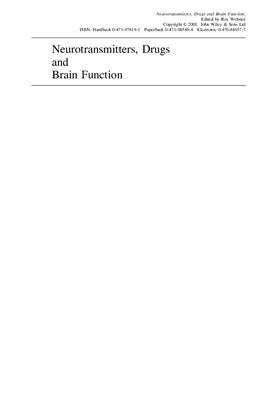Chichester-New York-Weinheim-Brisbane-Singapore-Toronto :John Wiley
& Sons Ltd. 2001. – 534 p.
This book is about neurotransmitters, the substances released from neurons to act on neurons. It covers what they do, how they do it and how their activity is involved in brain function and affected by drugs and disease.
After an overview of neurotransmitter systems and function and a consideration of which substances can be classified as neurotransmitters, section A deals with their release, effects on neuronal excitability and receptor interaction. The synaptic physiology and pharmacology and possible brain function of each neurotransmitter is then covered in some detail (section B). Special attention is given to acetylcholine, glutamate, GABA, noradrenaline, dopamine, 5-hydroxytryptamine and the peptides but the purines, histamine, steroids and nitric oxide are not forgotten and there is a brief overview of appropriate basic pharmacology.
How the different neurotransmitters may be involved in the initiation and maintenance of some brain disorders, such as Parkinson's disease, epilepsy, schizophrenia, depression, anxiety and dementia, as well as in the sensation of pain, is then evaluated and an attempt made to see how the drugs which are used in these conditions produce their effect by modifying appropriate neurotransmitter function (section C). The final section (D) deals with how neurotransmitters are involved in sleep and consciousness and in the social problems of drug use and abuse.
The contents are based on lectures given by the contributors, all of whom are experienced in research and teaching, in a neuropharmacology course for final-year BSc students of pharmacology, physiology, psychology and neuroscience at University College London. The text should be of value to all BSc students and postgraduates in those and related disciplines. Those studying medicine may also find it useful especially if working in neurology or psychiatry.
We have tried to make the book readable rather than just factual and so references have been kept to a minimum, especially in the early chapters on basic neuro-pharmacology and although more are given in the applied sections, they are selective rather than comprehensive.
This book is about neurotransmitters, the substances released from neurons to act on neurons. It covers what they do, how they do it and how their activity is involved in brain function and affected by drugs and disease.
After an overview of neurotransmitter systems and function and a consideration of which substances can be classified as neurotransmitters, section A deals with their release, effects on neuronal excitability and receptor interaction. The synaptic physiology and pharmacology and possible brain function of each neurotransmitter is then covered in some detail (section B). Special attention is given to acetylcholine, glutamate, GABA, noradrenaline, dopamine, 5-hydroxytryptamine and the peptides but the purines, histamine, steroids and nitric oxide are not forgotten and there is a brief overview of appropriate basic pharmacology.
How the different neurotransmitters may be involved in the initiation and maintenance of some brain disorders, such as Parkinson's disease, epilepsy, schizophrenia, depression, anxiety and dementia, as well as in the sensation of pain, is then evaluated and an attempt made to see how the drugs which are used in these conditions produce their effect by modifying appropriate neurotransmitter function (section C). The final section (D) deals with how neurotransmitters are involved in sleep and consciousness and in the social problems of drug use and abuse.
The contents are based on lectures given by the contributors, all of whom are experienced in research and teaching, in a neuropharmacology course for final-year BSc students of pharmacology, physiology, psychology and neuroscience at University College London. The text should be of value to all BSc students and postgraduates in those and related disciplines. Those studying medicine may also find it useful especially if working in neurology or psychiatry.
We have tried to make the book readable rather than just factual and so references have been kept to a minimum, especially in the early chapters on basic neuro-pharmacology and although more are given in the applied sections, they are selective rather than comprehensive.

